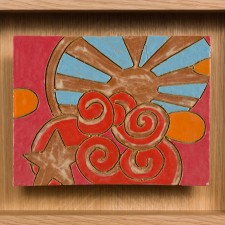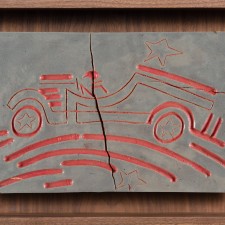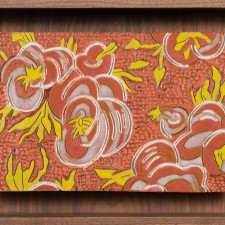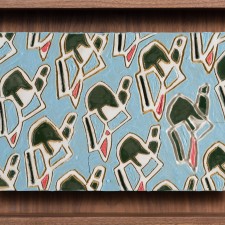Propaganda Fabric Tiles at UNTITLED, Art Online 2020
July 31 – August 2, 2020

PRESS RELEASE
Charles Moffett is pleased to present 19 new ceramic paintings by Los Angeles-based artist Bari Ziperstein, for the first edition of UNTITLED Online. This series of wall works include 17 small and 2 large, which are both paintings and sculptures. Ziperstein’s newest body of work is a continuation of her ongoing investigation of Soviet-era textile design and patterns. Previous bodies of work include Patterns of Propaganda, shown at Charles Moffett, New York in March 2019; Propaganda Pots at Nino Mier, Los Angeles in January 2018 and Fair Trade at UCSB Art, Architecture and Design Museum, Santa Barbara in January 2017.
Ziperstein’s newest ceramics investigate Soviet-era textile pattern swatches through a series of drawings on clay slabs. Using her previous research of textile swatches from the collection archives of the Wende Museum of the Cold War in Culver City, California, Ziperstein created some preliminary one-to-one translations of patterns onto clay by carving directly into slabs. What began as an exercise evolved into a whole series of ceramic paintings. Unlike Ziperstein’s previous investigations of translating imagery onto sculpture in-the-round, she found herself interested in the idea of fragmentation and how a repeat pattern could continue beyond its own limits simply by its own design. Thinking about what swatches may represent to a consumer, and what one does with a swatch, Ziperstein wondered what it could mean to live with a solid representation of the, otherwise temporary, cutout of a larger textile embedded in a deep history.
Immediately following the Russian Revolution, Russia faced shortages of most consumer goods, including fabric. As production was spurred to meet need, designers renounced pre-war European motifs that recalled the very class structures that Soviet Socialism claimed to abolish, favoring abstract geometric patterns over images of nature and historical events. These geometric patterns set the stage for a renewed interest in a uniquely Soviet style of representation and the potential for textile design to depict images of Soviet ideals. Avant-garde artists turned industrial designers like Varvara Stepanova and Liubov Popova expanded their repeated abstract imagery to include images like hammers, cogs, smokestacks, and vibrant young workers to project the ideals of the modern, communal proletariat. The designs are visually stunning, featuring deep, bright colors and bold, often kaleidoscopic patterns. By appropriating and recontextualizing these formal patterns, Ziperstein aims to remind us of historical patterns of oppression, upheaval, and revolution.
The artist’s new slab works are often almost to scale with their corresponding original swatch patterns. About half of the series represents the more traditional, geometric or figural patterns we might associate with Soviet-era imagery of industry and mechanics, while the other half is inspired by dynamic floral patterns. The works are rendered by freehand drawing with a fine needle and carving tools – finished in saturated high-fire glazes. Each piece is floating in a custom frame.




















